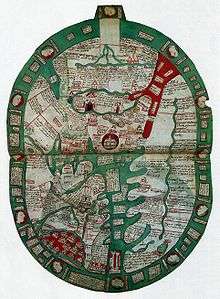Ranulf Higden
Ranulf Higden or Higdon (c. 1280 – 12 March 1364) was an English chronicler and a Benedictine monk of the monastery of St. Werburgh in Chester.[1] He is believed to have been born in the West of England, took the monastic vow (Benedictine), at Chester in 1299, and seems to have travelled over the north of England.
Biography
Higden was the author of the Polychronicon, a long chronicle, one of several such works of universal history and theology. It was based on a plan taken from Scripture, and written for the amusement and instruction of his society. It closes the long series of general chronicles, which were soon superseded by the invention of printing. It is commonly styled Polychronicon, from the longer title Ranulphi Castrensis, cognomine Higden, Polychronicon (sive Historia Polycratica) ab initio mundi usque ad mortem regis Edwardi III in septem libros dispositum. The work is divided into seven books, in humble imitation of the seven days of Genesis, and, with exception of the last book, is a summary of general history, a compilation made with considerable style and taste. Written in Latin, it was translated into English by John of Trevisa (1387), and printed by Caxton (1480), and by others. For two centuries it was an approved work.

It seems to have enjoyed considerable popularity in the 15th century. It was the standard work on general history, and more than a hundred manuscripts of it are known to exist. The Christ Church manuscript says that Higden wrote it down to the year 1342; the fine manuscript at Christ's College, Cambridge, states that he wrote to the year 1344, after which date, with the omission of two years, John of Malvern, a monk of Worcester, carried the history on to 1357, at which date it ends.
According, however, to one editor, Higden's part of the work goes no further than 1326 or 1327 at latest, after which time it was carried on by two continuators to the end. Thomas Gale, in his Hist. Brit. &c., scriptores, xv. (Oxon., 1691), published that portion of it, in the original Latin, which comes down to 1066.
Three early translations of the Polychronicon exist. The first was made by John of Trevisa, chaplain to Lord Berkeley, in 1387, and was printed by Caxton in 1480; the second by an anonymous writer, was written between 1432 and 1450; the third, based on Trevisa's version, with the addition of an eighth book, was prepared by Caxton. These versions are specially valuable as illustrating the change of the English language during the period they cover.
The Polychronicon, with the continuations and the English versions, was edited for the Rolls Series (No. 41) by Churchill Babington (vols. i. and ii.) and Joseph Rawson Lumby (1865–1886).[2] This edition was adversely criticized by Mandell Creighton in the Eng. Hist. Rev. for October 1888. There is a recent translation of his sermones by Margaret Jennings and Sally A. Wilson.[3]
He is buried in Chester Cathedral.
See also
Notes
- ↑ "Ranulf Higden". Encyclopædia Britannica Online. Retrieved 2 Aug 2010.
- ↑ C. Babington & J.R. Lumby, Polychronicon Ranulphi Higden Monachi Cestrensis together with the English Translations of John Trevisa and of an Unknown Writer of the Fifteenth Century, RS 41, 1865-68.
- ↑ Ranulph Higden, Ars componendi sermones. Translated by Margaret Jennings and Sally A. Wilson. Introduction and Notes by Margaret Jennings (Dallas Medieval Texts and Translations 2). Louvain/Paris: Peeters, 2003. ISBN 978-90-429-1242-7.
References
 Lane-Poole, Reginald (1887). "Chester, Roger of". In Stephen, Leslie. Dictionary of National Biography. 10. London: Smith, Elder & Co. pp. 203–204.
Lane-Poole, Reginald (1887). "Chester, Roger of". In Stephen, Leslie. Dictionary of National Biography. 10. London: Smith, Elder & Co. pp. 203–204. - Taylor, John (2004). "Higden, Ranulf (d. 1364)". Oxford Dictionary of National Biography. Oxford University Press.
 This article incorporates text from a publication now in the public domain: Cousin, John William (1910). "Higden, Ranulf or Ralph". A Short Biographical Dictionary of English Literature. London: J. M. Dent & Sons. Wikisource
This article incorporates text from a publication now in the public domain: Cousin, John William (1910). "Higden, Ranulf or Ralph". A Short Biographical Dictionary of English Literature. London: J. M. Dent & Sons. Wikisource
External links
| Wikisource has the text of a 1911 Encyclopædia Britannica article about Ranulf Higden. |
- Full text of the Polychronicon and Trevisa's English translation in Google Books
- Polychronicon, 091 H534 at L. Tom Perry Special Collections, Brigham Young University
- Works by or about Ranulf Higden at Internet Archive
- Works by Ranulf Higden at LibriVox (public domain audiobooks)
